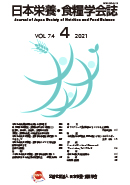
- Issue 6 Pages 281-
- Issue 5 Pages 255-
- Issue 4 Pages 147-
- Issue 3 Pages 121-
- Issue 2 Pages 69-
- Issue 1 Pages 3-
- |<
- <
- 1
- >
- >|
-
(JSNFS Award for Technology and Innovation (2020))Ryosuke Matsuoka, Mamoru Kimura, Kazuto Arimitsu, Takashi Kojima2021 Volume 74 Issue 4 Pages 147-154
Published: 2021
Released on J-STAGE: August 26, 2021
JOURNAL FREE ACCESSAlthough egg white protein is known to have high nutritional function, little research has been conducted on its health benefits. Previous basic research studies have focused on the quality of egg white protein as a protein source, and it has been shown to increase body protein and muscle mass to a greater extent than casein, while decreasing body fat and visceral fat mass. However, since it is relatively difficult for humans to consume a large amount of egg white continuously, lactic fermented egg white has been developed by fermenting egg white with lactic acid bacteria to improve its flavour. A study conducted in participants with high visceral fat showed that lactic fermented egg white improved visceral fat obesity and that the effects were attributable mainly to inhibition of lipid absorption by ovalbumin. Lactic fermented egg white not only makes it easy to consume high-quality protein but is also expected to serve as a protein source that can be used to prevent lifestyle-related diseases, thereby contributing to health maintenance and improvement.
View full abstractDownload PDF (1110K)
-
Moe Oshima, Erika Suzuki, Hayato Ihara, Kouhei Nagai, Kunihiro Kishida2021 Volume 74 Issue 4 Pages 155-169
Published: 2021
Released on J-STAGE: August 26, 2021
JOURNAL FREE ACCESSIt has been pointed out that excessive intake of fructose is associated with the development of metabolic syndrome. The physiological effects of fats and oils differ greatly depending on the fatty acids they contain. This study compared the effects of different fats and oils in a high fructose diet in rats. When the rats were fed a high fructose diet containing fish oil (FO), soybean oil (SO) or medium-chain triglycerides (MCT) using lard (LD) as a control for 4 weeks, the FO group exhibited a remarkable improvement in lipid metabolism. Although the SO group exhibited a decrease in hepatic lipids, the effect was smaller than that in the FO group. In the MCT group, the expression of genes related to fatty acid synthesis in mesenteric fat was remarkably high, and no improvement of lipid metabolism was observed. The hepatic protein expression profile in the FO group differed from that in the other groups. Increased protein expression associated with fatty acid oxidation and the oxidative stress response was observed in the FO group. These results revealed a difference in the physiological effects of fats and oils in a high fructose diet.
View full abstractDownload PDF (1443K)
-
Takeshi Yasui, Masato Matsumoto, Tomoko Watanabe, Akemi Yasui2021 Volume 74 Issue 4 Pages 171-180
Published: 2021
Released on J-STAGE: August 26, 2021
JOURNAL FREE ACCESSThe Standard Tables of Food Composition in Japan―2020― (Eighth revised edition, hereafter STFCJ 2020) use an altered energy calculation method, different from the method used for the Standard Tables of Food Composition in Japan―2015― (Seventh revised edition, hereafter STFCJ 2015). In STFCJ 2020, when available, protein calculated from the sum of amino acid residues (PROTCAA) and fat expressed as triacylglycerol equivalent of fatty acids (FATNLEA) are used for energy calculation together with other energy-yielding components, instead of protein calculated from reference nitrogen content (PROT-) and fat determined by one of 11 food-specific extraction methods (FAT-). The aims of this lecture are to detail the new energy calculation method used in STFCJ 2020 and to explain the newly introduced procedures for evaluating the uncertainty of dry matter content, i.e., the total mass of food components except water, and for choosing one of two available carbohydrate components (available carbohydrate expressed in monosaccharide equivalents 〈CHOAVLM〉 or available carbohydrate by difference 〈CHOAVLDF-〉) for inclusion in the energy calculation. Energy values calculated using the two methods employed in STFCJ 2020 and STFCJ 2015 are graphically compared among food groups, among energy conversion factors used in STFCJ 2015, and among combinations of preferred/acceptable methods for protein, fat and available carbohydrate analyses described in an FAO report, i.e., Food energy - methods of analysis and conversion factors, Report of a technical workshop, FAO Food and Nutrition paper 77 (2003). Furthermore, the influences of the resulting differences in energy values on the energy intake of Japanese are discussed using food intake data from the National Health and Nutrition Survey.
View full abstractDownload PDF (888K)
- |<
- <
- 1
- >
- >|